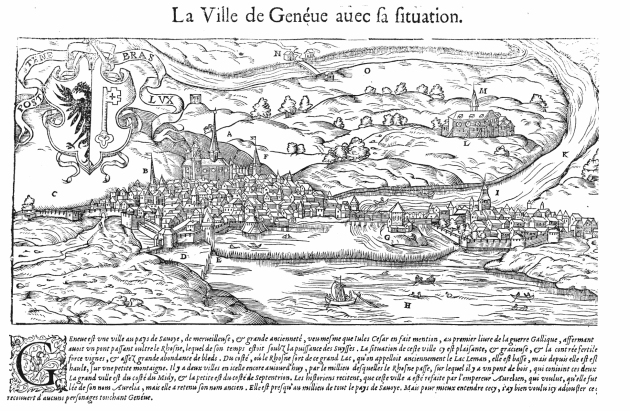Geneva, Imperial city and Episcopal principality (11th-16th century)
Up until the 11th century, Geneva was part of the kingdom of Burgundy before passing to the Holy Roman Empire whereby she acquired the status of imperial city and Episcopal principality. Falling directly under imperial authority, Geneva depended only on the emperor and the prince-bishop, feudal lord of the city and holder of both spiritual and temporal powers. As a prince of the Empire, the bishop had regalian rights, namely the privilege of coining money, raising an army, along with the right to dispense justice and collect taxes. As a prince of the church, his spiritual position debarred him from the right to spill blood or to take military action. To remedy these restrictions, the bishop had this function handed over to lay lords born of two rival houses. The execution of judiciary sentences (high justice) was entrusted to the counts of Geneva while a vidame[1] from the House of Savoy[2]handled civil cases (medium and low justice). The Bishop further enjoyed the assistance of a cathedral chapter[3] which brought together the sons of aristocratic families or university qualified lawyers. The rivalry between the houses of Savoy and Geneva regarding both territorial matters and the functions they fulfilled for the bishop lasted until 1401 at which point the county of Geneva was irrevocably absorbed into the county of Savoy. With no rival of an equal standing, the house of Savoy henceforward set its sights on the bihsop's rights and possessions, not least Geneva but it had to reckon with the city's growing municipal muscle.

Ever since the 13th century even as the rival houses fought it out, a communal movement had developed in Geneva. The increase of fairs and markets held on a regular basis, the city's expansion attendant on its economic and demographic growth, within and without its walls, contributed to the setting up of an assertive commune. A late-comer on the European scene, the commune originally consisted of a sworn association[5] of tradesmen and merchants. In 1387, Bishop Adhémar Fabry[6] legitimated communal power, confirming pre-existing Genevan « liberties, franchises[7], immunities, uses and customs »
. The recording in written form of the « franchises »
set down the city's rights and furthered institutional continuity. Right up to the end of the Ancien Régime[8], « Adhémar Fabry's franchises »
would stand for Genevan autonomy. The Commune structured itself around two institutions. The first was the General Council[9] which brought together the Citizens[10], the burghers[11] and the habitants[12] twice a year in the cloister of St Peter : in February to elect the syndics and in November to fix the price of wine. Sole only competent authority to accept a new tax or to raise a loan, the General Council could be called outside those dates in order to make decisions at short notice on specific matters. The city's second decisional structure was the Little Council[13] which constituted the executive power and numbered four Syndics[14] supported by twelve or twenty Citizens. Members of the Little Council from whom four syndics were drawn on a yearly basis were appointed for life. The Little council administered criminal justice, managed city finances, dealt with public order and public works. The syndics, as chief magistrates had the authority to pass sentence in criminal cases and to swear in the vidame who committed to respect the Franchises. They may also declare a truce without the prince- bishop's approval though it must be ratified by the General Council. As from 1409, the Little Council's proceedings were recorded in writing. Thus the Councils amounted to municipal institutions that were to hold good throughout the Ancien Régime although the powers they were endowed with varied at different times and were source of frequent conflicts.







